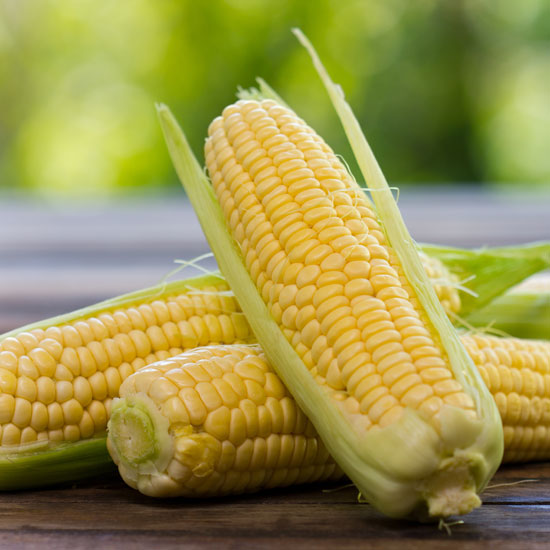Made at Home Vegetables, by Dick Strawbridge and James Strawbridge (Mitchell Beazley, 2012), proves just how productively green you can be all year round. Whether you have a tiny urban plot, a terrace, a community garden allotment or plenty of space in your own garden, growing your own vegetables is one of the easiest ways to transform the way you eat. The following excerpt from the chapter “Summer” teaches you how to grow and harvest sweetcorn.
Purchase this book from the GRIT store:Made at Home Vegetables.
It wasn’t that long ago that we started growing our own sweetcorn and we didn’t succeed straight away, but eventually we learnt how to get good results and a proper home-grown crop. There are a lot of varieties available, so do a little research and choose the one that will best suit your garden. Sweetcorn is categorized by its sweetness, the time of year it will mature (early, mid season or late) and its colour (it can be white, yellow, or a mixture of the two).
Sow
In mid to late spring, sow kernels into small pots or module trays at a depth of 2.5 cm (1 inch). If you are using a larger pot, sow a couple of seeds in each pot and thin the seedlings out later when one has established itself as stronger.
Grow
Protect the seedlings from frost and harden the seedlings off gradually. Transplant them when they are 10-15cm (4-6 inches) tall. Sweetcorn is wind-pollinated and needs to be planted in blocks rather than rows. Leave 45cm (18 inches) between plants and position them in a cross formation. Sweetcorn needs a sunny position, sheltered from strong winds. If your garden is very windy, use stakes to support the plants. When the sweetcorn is in flower make sure to give it extra watering.
To improve your chances of getting full cobs of sweetcorn with plenty of ripe kernels inside, tap the tassels that sprout out of the top of the cobs. This will help the plants to pollinate successfully.
Companion Planting
There is a classic inter-planting technique that works incredibly well with sweetcorn. Plant courgettes, squash or pumpkin around the base of the plants. These help to retain the moisture in the soil, due to their big leaves, and also reduce weed growth by keeping the soil shady. Then plant some climbing beans around the foot of the sweetcorn so that they can grow up it. The stem of the sweetcorn will serve as a natural trellis for the beans to grow up. The advantage to this style of growing is that you end up with 3 crops all being productive in the same space — excellent if you are short of gardening space.
Pests & Diseases
Slugs and snails can be a problem. Surround your young transplants with a plastic bottle to discourage them. Cut a ring of plastic from a 2 litre (3 1/2 pint) bottle and chop a sharp zigzag shape around the top. We’ve found that this effectively protects the vulnerable stems. You could also try putting coffee granules, sheep-wool, slug pellets or copper tape around the base of the plants.
Harvest
Harvest your sweetcorn when the tassels have started to turn brown and the kernels are a golden colour. Not every variety will be bright yellow, so a good test is to squeeze a kernel and if it gives out a little cream-coloured substance then they are ready to harvest. If what comes out is clear and watery, leave the sweetcorn for a little longer. When you pick your corn, twist the whole cob off the plant.
Store
Sweetcorn is at its very best just after it has been picked, but the flavours and sweetness will fade as soon as the sugars begin turning to starch, so it is best to use it within a couple of days of harvesting. However, you can freeze whole cobs — blanch them for about 5 minutes and then freeze them in a sealed freezer bag. Alternatively, you can spread the kernels on a baking sheet and dry them in an oven set at a very low temperature for 10-12 hours. Rehydrate the dried kernels for 6 hours before using them.
Eat
We particularly enjoy eating corn on the cob — sweetcorn is delicious boiled and smothered in melted butter with a little seasoning. You could also try marinating cobs and cooking them on the barbecue, or roasting them in a hot oven (with the husks still on) for 8-15 minutes.
More from Made at Home Vegetables
• Grow Large, Juicy Garlic Bulbs
• Garlic Pizzas Recipe
• Sweetcorn Fritters With Salsa and Lime Mayo Recipe
• How to Grow Fennel
• Roasted Fennel With Blue Cheese and Chestnuts Recipe
• Grow White and Purple Kohlrabi
• Kohlrabi Coleslaw Recipe
Reprinted with permission from Made at Home Vegetables, by Dick Strawbridge and James Strawbridge, and published by Mitchell Beazley, 2012. Buy this book from our store: Made at Home Vegetables.





